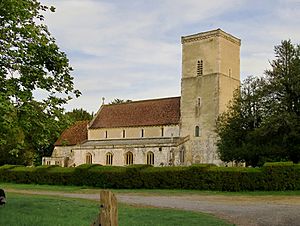All Saints' Church, Netheravon facts for kids
Quick facts for kids All Saints' Church, Netheravon |
|
|---|---|

All Saints' Church from the north-west
|
|
| Lua error in Module:Location_map at line 420: attempt to index field 'wikibase' (a nil value). | |
| Location | Netheravon, Wiltshire |
| Denomination | Anglican |
| History | |
| Founded | 11th century or earlier |
| Dedication | All Saints |
| Architecture | |
| Heritage designation | Grade I |
| Designated | 1964 |
| Style | Anglo-Saxon, Norman, Early English Gothic |
| Specifications | |
| Materials | Flint |
| Bells | 6 |
| Tenor bell weight | 19cwt-2qrs-0lbs in E |
| Administration | |
| Parish | Netheravon |
| Benefice | Avon River Team |
| Deanery | Stonehenge |
| Archdeaconry | Sarum |
| Diocese | Salisbury |
| Province | Canterbury |
The Church of All Saints is a special church in the village of Netheravon, Wiltshire, England. It's a Church of England parish church, which means it serves the local community. This church has been standing on this spot near the River Avon for a very long time, even since the Saxon people lived here. It's considered a very important building, so it's been given a special status called a Grade I listed building. This means it's protected because of its history and unique design.
Contents
A Look Back: The Church's Story
Early Beginnings: Saxon Times
Long ago, before the Norman Conquest in 1066, Netheravon was a big and successful village. The size of the church's oldest parts shows this. By the early 1000s, there was already a church here shaped like a cross. It had a tower in the middle, a main hall called a nave, and a small rounded end called an apse.
Norman Changes and Later Additions
When the Doomsday survey was done in 1086, the church was described as being in ruins. But it was rebuilt soon after, during the early Norman period. Many parts of that Norman work are still visible today. The tower was made taller when the church was rebuilt, but it still used its original base.
The main hall (nave) and the area around the altar (chancel) were rebuilt again in the 1200s. Some older Norman parts were kept. The side sections, called aisles, were rebuilt in the 1400s. Part of the roof was replaced in the early 1600s. New pointed tops, called pinnacles, were added to the tower in 1626, but these have since been removed.
Modern Updates and Repairs
The church had a big restoration starting in 1888. This work included smoothing the walls with plaster and making the roof higher. The south aisle was made longer, and the arch leading to the chancel was replaced. In the early 1980s, a large crack was found in the tower. About £50,000 was spent to fix and restore it.
What Makes the Church Special?
For a small village, the Church of All Saints is quite large and impressive. Its most important feature is the big West Tower. This tower is mostly a Saxon structure. This makes it a rare example of a large building that survived from before the Norman Conquest. Experts have different ideas about how old the tower is. Some think it's as old as the 800s, while others say the 1000s. Most agree that the bottom half of the tower was the original central tower of the church built before the Normans arrived. It was made taller in the 1000s and 1100s.
Inside the tower, there are two large arches from before the Norman Conquest. One has a door from the 1000s on the west side, which is the main entrance to the church. The other is a taller, round arch, about 19 feet (5.8 meters) high, on the east side. This arch connects the tower to the main hall (nave). Historic England has called this arch "most impressive."
The main hall (nave) was built in the 1200s. It has a simple Early English style, with tall, narrow windows called lancet windows. It also has a small clerestory, which is a row of windows high up on the wall. The nave roof is quite high and steeply sloped. The area around the altar (chancel) was also built in the 1200s. It has simple lancet windows and a large window with three lights on the east side. The nave and chancel used to be connected by an arch from the 1200s. However, this arch was taken down and rebuilt in 1888 in a style that looked back to Romanesque designs.
The Church Bells
The tower holds a heavy set of six bells. The largest bell, called the tenor, weighs about 19 and a half hundredweight, which is about 991 kilograms. It is tuned to the note E. In 1553, the church had three bells and a small bell called a sanctus bell. More bells were added or remade later. In 1585, John Wallis of Salisbury bell foundry made one, and in 1695, Samuel Knight made another. By 1609, there was also a treble bell, but we don't know who made it. By 1911, the church had five bells.
In 1911, the bells had a big update by John Taylor & Co from Loughborough, Leicestershire. This work included remaking the 1609 treble bell and the 1588 tenor bell. The other bells were retuned. They also added a new treble bell, making a total of six bells. All the bells were then rehung in a new metal frame.
The fifth bell was later replaced in 1945, also by John Taylor & Co. So, the church now has six bells. Four of these bells were made by Taylor: three from 1911 and one from 1945. The other two older bells, from 1585 and 1695, are still there. Today, they are the 4th and 3rd bells in the set.

